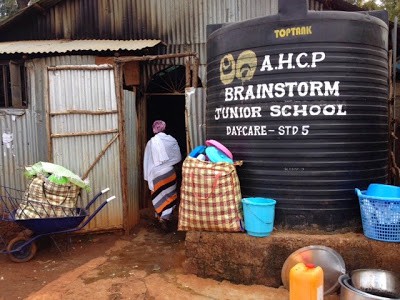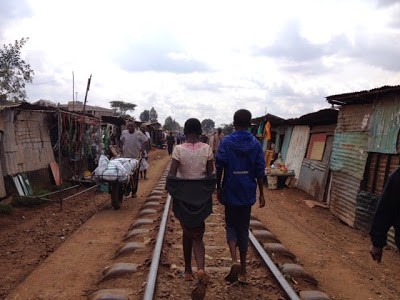
I want to begin by addressing a bit of the controversy surrounding “slum tours.”
Slum tourism has sparked debate around the morality of this kind of interaction of privileged individuals visiting impoverished, marginalized and underserved communities.
It is basically known to many as poverty porn or poverty tourism and many people see it as a way for privileged people to gawk at those from less fortunate backgrounds.
On the flip side, it can be argued that this type of tourism raises awareness and provides a way for tourists to give back to the local communities they visit.
I am not going to say that slum tours are right (or wrong), because I truly believe, that like most things of this nature, it is complex.
At the end of the day, I am glad that I personally partook in a guided tour of the Kibera Slums with Joshwa, the extremely knowledgeable and inspiring co-founder of the Kibera Community Empowerment Organization (KCEO).
As an international aid worker who studied international development, I understand how a slum tour can exploit a vulnerable community though.
There is a fine line between exploiting poverty and raising awareness, but it’s hard to deny that there are pros to “slum tourism” when it’s done respectfully.
In my case, I was on a tour for a specific purpose, to visit the Kibera Community Empowerment Organization and my tour fee went to support the grassroots community projects they started.
The way I see it, if you are visiting a nonprofit that you are donating to, the tour is done respectfully (e.g. you aren’t shoving a camera in people’s faces or capturing their private lives on film without permission, and are also not posting pictures of people’s faces on your social media platforms), you aren’t making money off of the experience, the money exchanged goes back into a community project and isn’t pocketed by just one individual, and the visitors go home with a deeper understanding of the complexities of urban poverty- it’s hard for me to deny that this has the potential to be a powerful cultural exchange.
That all being said, and without any conclusions on the morality of a ‘Slum tour’–I feel it is important to share my experience, both to spread awareness about income inequality and to spotlight a really inspiring local Kenyan organization combatting it.
I’m still not certain I can find the words to describe the level of extreme poverty in this monumentally dense urban slum. Nor do I know if I can paint an accurate picture of what 1 million people on 2.5 square kilometers looks like in the middle of a city of 4 million. But I will certainly try.
It is important to keep in mind, that Kibera is considered the largest urban slum in Africa and is located about 4 miles from Nairobi’s city center. It is estimated to have a population of one million people and is made up of many different villages and tribes. Most of the residents live on less than $1USD per day.
As I solemnly stumbled down the hill, half staring at the ground and my shoes, trying to avoid stepping in sewage or mud, not that I could differentiate the two, I tried not to make eye contact with anyone for too long.
At first, no one seemed to notice us despite the blatant contrast between the color of my skin, the quality of my clothes, and the touristy konga fabric shoulder bag I gripped in front of me.
Then the “mzungus” (meaning white person in Swahili) started as we walked past the police station composed of two shipping containers stacked one on top of the other with official letters painted on the side: “police post”.
I smiled awkwardly but quickly stopped because I thought that might be inappropriate. But what is the appropriate way to approach strangers in a place where you both know the truth, and you are on opposite sides of privilege?
As we wandered deeper into the heart of it all, I began to smile and wave at children in response to their small eager voices shouting “hi, how are you?” in innocent unison. Some giggled bashfully, some stuck their hands out to make contact, and others ran away. But their faces lingered in my mind as I walked through their streets and trespassed on the land that neither of us held legal claim too.
As we came to a bridge that offers a dry path over the narrow river that dissects the slums, I avoided eye contact with a frail, sick woman being carried by two others with a look of seriousness in their eyes. I didn’t want her to know I could feel her pain radiating off her like a thick presence in the air, because her struggle was beyond my expertise or business. She was probably too far gone to notice my intrusion, but I felt uncomfortable bearing witness to her suffering none the less.
Past her, was a group of small children laughing on the bridge, dressed in tattered clothing. A girl with a contagious smile told me her name, and I murmured that it was pretty even though I wanted to say so much more. I wanted to know her story, and tell her that she mattered and that I’m sorry that she was born there and I was born into a house with multiple rooms, flushing toilets in every bathroom and beds. I tried to tell her with my eyes, but she smiled sheepishly and continued playing with her friends oblivious to my concerns.
A group of local young adults in matching neon green t-shirts that read: “I participated in cleaning up Kibera”, were clumped together jabbing sticks in the murky river trying to retrieve garbage that appeared to permanently pollute the water.
On the other side of the bridge, children circled around a small water hole immersing their hands in and splashing one another as they laughed and screamed with delight at the entertainment they’d found in a dirty puddle. I didn’t know if I felt sad because they had no store-bought toys or regard for hygiene and health, or happy because they were unaware and full of smiles regardless.
As we continued through the narrow corridors up and down steep and unstable ground, I couldn’t help but notice the various pipes and wires bulging across the path begging to trip anyone not careful enough to mind their step. On the right, I caught a glimpse of two sleeping piglets and on the left a couple of children carrying puppies by the scruff on their necks.
Gravity forced the sewage down the center of the path in a steady stream as I tried to dodge its persistent flow while children and elders scurried past me with no regard for their footing.
Eventually, we reached the Human needs project town center: place of hope, opportunity, and action. With the mission statement: provision of integrated quality services for holistic sustainable solutions to the challenges of living in slums. The modern multiple level structure offered a cafe with nutritional snacks, laundry, internet and computers, showers and toilets for a seemingly small fee of 5KSH (10 U.S. cents)–however I later learned that this fee is rather high for the locals in most dire need of the services offered there.
The walls inside the impressively clean and out of place structure were lined with remarkable acrylic paintings done by children in the slums to fund their own education. I felt drawn to the skilled brush strokes of a boy named Joseph’s zebra piece with strong white and black stripes surrounded by a flurry of color. I decided I couldn’t leave without it. So, I handed over $70 to a cause I don’t know everything about, but I could not walk away without a small attempt to contribute.
I left the center inspired but slightly conflicted by the anomaly of how such a structure is truly benefiting the community when many of the slum residents can’t afford the services.
We followed the train tracks littered with trash and people. Along the sides, you could buy any number of random items from the many stores displayed in front of metal shacks. We passed a tarp laid out with various types of used locks with a worn old man sitting patiently behind it.
A little further ahead a small girl sat alone next to a basket full of unidentified food. We smiled at each other, but my legs kept moving forward, careful not to linger too long and get her hopes up that I was going to buy something.
As we were strategically guided through the mounds of garbage, streams of sewage and sick people I pondered what it is like to live in Kibera. Sleeping under scraps of metal and plastic tied desperately together for shelter, or even one of the more natural mud huts bound with rotten wooden beams on a hill. Sharing a tight 10 by 10ft space with ten people and no bed, and with nothing but the closeness of fellow bodies on the dirt floor for warmth.
As I pondered this reality for the one million slum dwellers, the structures started to shift abruptly into bigger houses made of more stable materials. We passed what can only be assumed as the homes of slum lords (or the politically correct title “Area Chief”), rigged with electricity and other prized possessions. Even the products improved and became more expensive in the shops closer to the outskirts of the slums. An unaccompanied stand of TVs, printers, and microwaves sat in front of a school converted into a church made of refurbished metal scraps with USAID’s emblem painted across the side.
My thoughts didn’t wander for too long before we arrived at the KCEO office, where we met some of the other staff. The office itself was a small room less than 10 feet wide or long and had three desks containing a handful of outdated computers. Our guide Joseph showed me a binder with the subject matter they cover in their youth behavioral change programs ranging from Sex Education to anti-corruption. He explained how he used the plastic they collected around the slums to make building materials and the profits are invested straight back into the community through their youth education programs.
As he spoke of passion being the only sustainable motivator, I became more inspired, hanging onto his every word. His genuine desire to change his community had turned into something real. Him and his friends managed to create tangible opportunities for their family and neighbors out of the literal trash around them. KCEO’s recycling programs have funded hundreds of kids school fees and with minimal operational costs. I was hooked.
I left the office a little more optimistic than I had entered, and the feeling began to grow as I walked past the same smiling kids who’s future’s suddenly seemed a little more hopeful. If two young boys from the slums could start something so impressive, what is to stop any of those smiling faces from changing their own future.
Injustice and vast income inequality is still very much alive and its presence is still heavy across the developing world, but the solutions are springing up exactly where they should be–from within.
I’m not sure what my day in the slums will mean for me long-term, but for now, I feel inspired. I peeked into the reality of urban poverty in Africa’s largest urban slum, but I found something unexpected. For the first time in a long while, I felt hope.
Check out the Kibera Community Empowerment Organization‘s work.
Buy a painting and help a child from Kibera fund their own education at the Uweza Shop.










Wow this is an amazing post! Really touched me. Thanks for sharing!